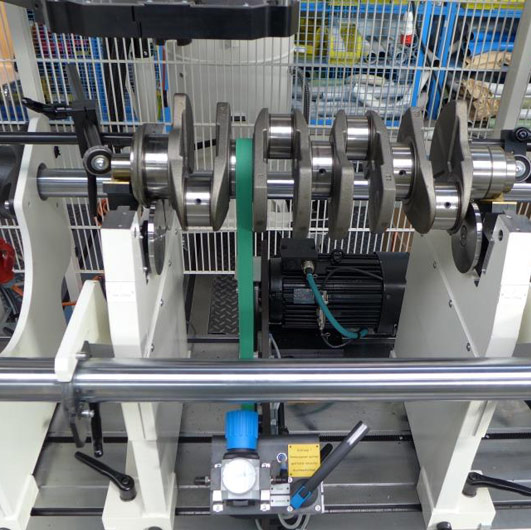Electronic Crankshaft Balancing + Heavy Metal
Electronic Crankshaft Balancing + Heavy Metal
Original Price: $450.00
Crankshaft balancing is important to your engine performance. Engine balance refers to how the forces (resulting from combustion or rotating/reciprocating components) are balanced within an internal combustion engine or steam engine. The most commonly used terms are primary balance and secondary balance. Unbalanced forces within the engine can lead to vibrations.
To better understand the mechanics of balancing, let’s look at the theory behind it. As everybody knows, a rotating object generates “centripetal force.” Centripetal force is an actual force or load generated perpendicular to the direction of rotation. Tie a rope to a brick and twirl it around and you’ll feel the pull of centripetal force generated by the “unbalanced” weight of the brick. The faster you spin it, the harder it pulls. In fact, the magnitude of the force increases exponentially with speed. Double the speed and you quadruple the force.
The centripetal force created by a crankshaft imbalance will depend upon the amount of imbalance and distance from the axis of rotation (which is expressed in units of grams, ounces or ounce-inches). A crankshaft with only two ounce-inches of imbalance at 2,000 rpm will be subjected to a force of 14.2 lbs. At 4,000 rpm, the force grows to 56.8 lbs.! Double the speed again to 8,000 rpm and the force becomes 227.2 lbs.
This may not sound like much when you consider the torque loads placed upon the crankshaft by the forces of combustion. But centripetal imbalance is not torque twisting the crank. It is a sideways deflection force that tries to bend the crank with every revolution. Depending on the magnitude of the force, the back and forth flexing can eventually pound out the main bearings or induce stress cracks that can cause the crank to snap.
The process of balancing begins by equalizing the reciprocating mass in each of the engine’s cylinders. This is done by weighing each piston on a sensitive digital scale to determine the lightest one in a set. The other pistons are then lightened to match that weight by milling or grinding metal off a non-stressed area such as the wrist pin boss. The degree of precision to which the pistons are balanced will vary from one engine builder to another, and depends to some extent on the application. But generally speaking pistons are balanced to within plus or minus 0.5 grams of one another.
Next the rods are weighed, but only one end at a time. A special support is used so that the big ends of all the rods can be weighed and compared, then the little ends. As with the pistons, weights are equalized by grinding away metal to within 0.5 grams. It’s important to note that the direction of grinding is important. Rods should always be ground in a direction perpendicular to the crankshaft and wrist pin, never parallel. If the grinding scratches are parallel to the crank, they may concentrate stress causing hairline cracks to form.
On V6 and V8 engines, the 60 or 90 degree angle between the cylinder banks requires the use of “bobweights” on the rod journals to simulate the reciprocating mass of the piston and rod assemblies. Inline four and six cylinder crankshafts do not require bobweights. To determine the correct weight for the bobweights, the full weight of a pair of rod bearings and the big end of the connecting rod, plus half the weight of the little end of the rod, piston, rings, wrist pin (and locks if full floating) plus a little oil are added together (100 percent of the rotating weight plus 50 percent of the reciprocating weight). The correct bobweights are then assembled and mounted on the crankshaft rod journals.
The crankshaft is then placed on the balancer and spun to determine the points where metal needs to be added or removed. The balancer indexes the crank and shows the exact position and weight to be added or subtracted. The electronic brain inside the balancer head does the calculations and displays the results. The latest machines have graphical displays that make it easy to see exactly where the corrections are needed.
If the crank is heavy, metal is removed by drilling or grinding the counterweights. Drilling is usually the preferred means of lightening counterweights, and a balancer that allows the crank to be drilled while still on the machine can be a real time saver.
If the crank is too light, which is usually the case on engines with stroker cranks or those that are being converted from externally balanced to internally balanced, heavy metal (a tungsten alloy that is 1.5 times as heavy as lead) is added to the counterweights. This is usually done by drilling the counterweights, then press fitting and welding the heavy metal plugs in place. An alternate technique is to tap the hole and thread a plug into place. Drilling the holes sideways through the counterweights parallel to the crank rather than perpendicular to the crank is a technique many prefer because it prevents the metal from being flung out at high rpm.
After drilling the crankshaft is again spun on the balancer to determine if additional corrections are required. If the crank is for an externally balanced engine (such as a big block Chevy), the balancing will be done with the flywheel and damper installed. On internally balanced engines, the flywheel and damper can be balanced separately, or installed on the crank and balanced as an assembly once the crank itself has been balance


Leave a Reply